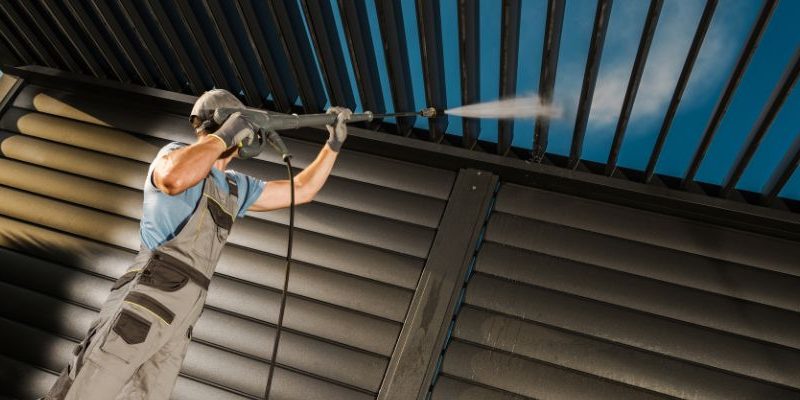A pergola not only enhances the beauty of your outdoor space but also defines and enriches your backyard retreat by providing shade and structure. However, like any outdoor feature, pergolas require regular maintenance to preserve their appearance and functionality. Over time, the accumulation of dirt, grime, mold, and mildew not only detracts from their aesthetic appeal but can also cause structural damage. Regular cleaning is crucial, and with the right tools and techniques, it can be straightforward. Understanding the pressure washing benefits can be particularly useful as this method effectively cleans and maintains the pristine condition of your pergola. In this detailed guide, we will explore how to maintain a pergola using a pressure washer, providing professional tips and insights to enhance your cleaning routine.
Table Of Content
Understanding the Importance of Pergola Maintenance
Preserving the Beauty and Integrity of Your Outdoor Space
Your pergola is not just a functional addition to your outdoor area; it’s also a design element that contributes to the overall ambiance of your space. Regular maintenance is crucial for preserving its beauty and structural integrity. Neglecting to clean your pergola can lead to the buildup of dirt, grime, and other debris, detracting from its visual appeal and potentially causing premature wear and tear.
Preventing Damage and Extending Lifespan
A well-maintained pergola can last for many years, providing you with countless hours of enjoyment. However, without proper care, it’s susceptible to damage from environmental factors such as sun exposure, moisture, and debris accumulation. Regular cleaning helps prevent issues such as mold, mildew, and rot, thereby extending the lifespan of your pergola and protecting your investment.
Enhancing Curb Appeal and Enjoyment
A clean, well-maintained pergola enhances the overall aesthetic of your outdoor space and boosts curb appeal. Whether you’re hosting outdoor gatherings, relaxing with a book, or enjoying a meal al fresco, a pristine pergola creates an inviting atmosphere that enhances your outdoor experience. By investing time and effort into regular maintenance, you can ensure that your pergola remains a focal point of beauty and enjoyment in your backyard.
Getting Started: Preparing for Pressure Washing
Gather Your Supplies and Equipment
Before you begin the cleaning process, gather all the necessary supplies and equipment. In addition to a pressure washer, you’ll need a sturdy ladder, safety goggles, gloves, a scrub brush, mild detergent or cleaning solution, and a garden hose. Take the time to inspect your pressure washer and ensure that it’s in good working condition, with no leaks or damage to the hoses or fittings.
Conduct a Safety Check
Safety should always be your top priority when using a pressure washer. Before starting, carefully read the manufacturer’s instructions and familiarize yourself with the equipment. Check the water supply and electrical connections to ensure they’re secure. Wear appropriate safety gear, including goggles to protect your eyes from debris and gloves to shield your hands. If you’re working on a tall pergola, use a sturdy ladder and have a spotter assist you to prevent accidents.
Prepare the Surrounding Area
Pressure washing can create a significant amount of overspray, so it’s essential to prepare the surrounding area before you begin. Remove any furniture, plants, or other objects near the pergola to prevent them from getting sprayed or damaged. Cover nearby surfaces such as windows, doors, and outdoor furniture with plastic sheeting or tarps to protect them from overspray and cleaning solution runoff.
Cleaning Your Pergola with a Pressure Washer
Start with a Rinse
Before applying any cleaning solution, it’s a good idea to give your pergola a thorough rinse with plain water. This helps remove loose debris and prepares the surface for cleaning. Begin at the top of the pergola and work your way down, using a wide-angle nozzle attachment to distribute the water evenly. Pay special attention to areas where dirt and grime are concentrated, such as crevices and joints.
Apply Cleaning Solution
Once the pergola is thoroughly rinsed, it’s time to apply a cleaning solution to tackle stubborn stains and mildew. Choose a mild detergent or a specialized cleaner formulated for outdoor surfaces. Dilute the cleaning solution according to the manufacturer’s instructions, and then apply it to the pergola using the pressure washer’s detergent attachment or a pump sprayer. Allow the solution to dwell on the surface for several minutes to loosen dirt and grime effectively.
Scrub Stubborn Stains
For particularly stubborn stains or areas of heavy buildup, you may need to use a scrub brush to agitate the cleaning solution. Work in small sections, applying gentle but firm pressure to lift away dirt and grime. Avoid using excessive force, as this can damage the surface of the pergola. If you encounter areas of mold or mildew, take extra care to thoroughly scrub and disinfect these areas to prevent regrowth.
Final Steps and Maintenance Tips
Rinse Thoroughly
Once you’ve finished scrubbing, rinse the pergola thoroughly with clean water to remove any remaining cleaning solution and debris. Again, start at the top and work your way down, ensuring that no residue is left behind. Pay close attention to areas where cleaning solution may have pooled, such as horizontal surfaces and crevices.
Allow to Dry Completely
After rinsing, allow the pergola to dry completely before replacing any furniture or accessories. Depending on the weather conditions and the material of your pergola, this may take several hours or even a full day. Avoid using the pergola until it’s completely dry to prevent slips and falls.
Schedule Regular Maintenance
To keep your pergola looking its best year-round, schedule regular maintenance tasks such as cleaning and sealing. Depending on your climate and environmental factors, you may need to clean your pergola every few months or at least once a year. In addition to pressure washing, inspect the structure periodically for signs of damage or wear, such as loose or damaged boards, rusted hardware, or chipped paint.
Final Wording
Cleaning your pergola with a pressure washer offers a convenient and effective solution for restoring its beauty and prolonging its lifespan. By following the pressure washing tips outlined in this guide and mastering the pressure washing process, you can breathe new life into your pergola and create an outdoor oasis to be enjoyed for years to come. At Pristine Connections, we’re here to help you achieve pristine results and make your outdoor dreams a reality. Contact us today to learn more about our professional pressure washing services and take the first step towards a cleaner, more beautiful pergola.
FAQ’s
Yes, pressure washing can be used to clean pergolas made of various materials, including vinyl and aluminum. However, it’s essential to adjust the pressure settings and use appropriate cleaning solutions to avoid damage.
Yes, it’s advisable to cover nearby plants and landscaping to protect them from overspray and potential damage during the pressure washing process. Use tarps or plastic sheeting to create a barrier between the pergola and surrounding vegetation.
Yes, pressure washing is effective at removing stubborn stains like mildew, bird droppings, and other organic matter from pergolas. However, for particularly stubborn stains, you may need to use a higher pressure setting or apply a specialized cleaning solution.
The frequency of pressure washing your pergola depends on various factors, including local climate, environmental conditions, and usage. As a general rule, it’s recommended to pressure wash your pergola at least once a year to maintain its appearance and integrity.
While pressure washing is generally safe for cleaning pergolas, using excessive pressure or improper technique can potentially damage the wood or paint surface. It’s essential to use caution and test a small area first to ensure compatibility with the pressure washer.







